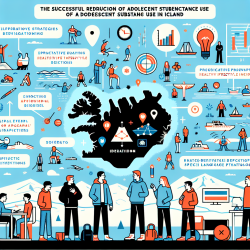Introduction
Substance use among adolescents is a pressing global concern, with significant implications for public health. The research article "Trends in prevalence of substance use among Icelandic adolescents, 1995–2006" provides valuable insights into how Iceland successfully reduced substance use among its youth. This blog will explore the key findings and strategies from this study, offering practitioners actionable insights to improve their skills and encourage further research.
Key Findings from the Research
The study analyzed trends in the prevalence of daily smoking, alcohol intoxication, and illicit substance use among Icelandic adolescents over an 11-year period. Key findings include:
- A significant decline in daily smoking from 23% in 1998 to 12% in 2006.
- A reduction in alcohol intoxication from 42% in 1998 to 25% in 2006.
- A decrease in hashish use from 17% in 1998 to 9% in 2006.
The study attributes these declines to a comprehensive community-based prevention strategy known as the Icelandic Model of Adolescent Substance Use Prevention.
The Icelandic Model: A Data-Driven Approach
The Icelandic Model emphasizes collaboration between researchers, policymakers, and practitioners to address substance use at multiple levels. Key components of this approach include:
- Parental Involvement: Educating parents on the importance of emotional support, monitoring, and spending quality time with their children.
- Community Engagement: Encouraging youth participation in organized recreational and extracurricular activities.
- School Collaboration: Strengthening networks between schools and community agencies to provide a supportive environment for adolescents.
This model underscores the importance of fostering protective factors while reducing risk factors for substance use. It highlights the role of societal influences and community attachment in preventing adolescent substance use.
Implications for Practitioners
Practitioners can draw several lessons from Iceland's success:
- Implement community-based strategies that involve parents, schools, and local organizations.
- Focus on building strong relationships between adolescents and their families.
- Promote participation in positive, structured activities to reduce the likelihood of substance use.
By adopting a holistic, data-driven approach, practitioners can create environments that support healthy adolescent development and reduce substance use.
Encouraging Further Research
The Icelandic experience demonstrates the potential of data-driven, community-based strategies in reducing adolescent substance use. However, further research is needed to explore the long-term impact of these strategies and their applicability in different cultural contexts. Practitioners are encouraged to conduct studies that examine the effectiveness of similar approaches in their communities.
To read the original research paper, please follow this link: Trends in prevalence of substance use among Icelandic adolescents, 1995–2006.










